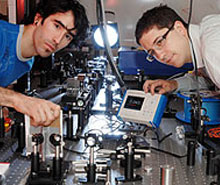Neurophysics Program – archives
The Neurophysics research program was the first in Canada at the interface between neurosciences, materials sciences and photonics.
The Director of the Neurophotonics Centre, Yves De Koninck, was the project leader of the Neurophysics CIHR Training Grant, funded by the Canadian Institutes of Health Research (CIHR).
Created in 2003, the Neurophysics group thrived towards setting new frontiers in neuroscience by:

- bringing together scientists from highly diversified disciplines (medicine, physics, biology, chemistry…);
- providing the highest ethical, technical and scientific standards and expertise to the students that will form the workforce of tomorrow;
- conducting fundamental and applied research at the interface of these sciences to get a better understanding of neurons and their operation;
- developing new biomedical characterization tools that will be minimally invasive.
Building bridges between disciplines and institutions
Progress in our understanding of neurons and their operation critically depends on our ability to improve our resolution of dynamic molecular mechanisms and on the availability of appropriate tools for real-time studies in live cells. The solution resides in using the latest advances in the fields of photonics and material sciences to develop new biomedical characterization tools that will be minimally invasive. To this aim, an active interdisciplinary collaboration was established between physicists, engineers and neuroscientists from four research centers and two universities: the Neurophotonics Centre, the Centre de recherche institut universitaire en santé mentale de Québec (CRIUSMQ, Neurosciences), the Centre d’optique, photonique et laser (COPL, Photonics) at Université Laval and the Center for the Physics of Materials (CPM, Materials Science) at McGill University.
The goal of the Neurophysics program was to provide expertise in Neuroscience research to highly qualified personnel from the fields of photonics and material sciences. This helped create a new generation of scientists proficient in a wide variety of fields. These men and women were then be able to develop new tools derived from the fields of physics and chemistry and apply them to the understanding of neurobiological questions, including the study of normal and pathological brain tissue.

